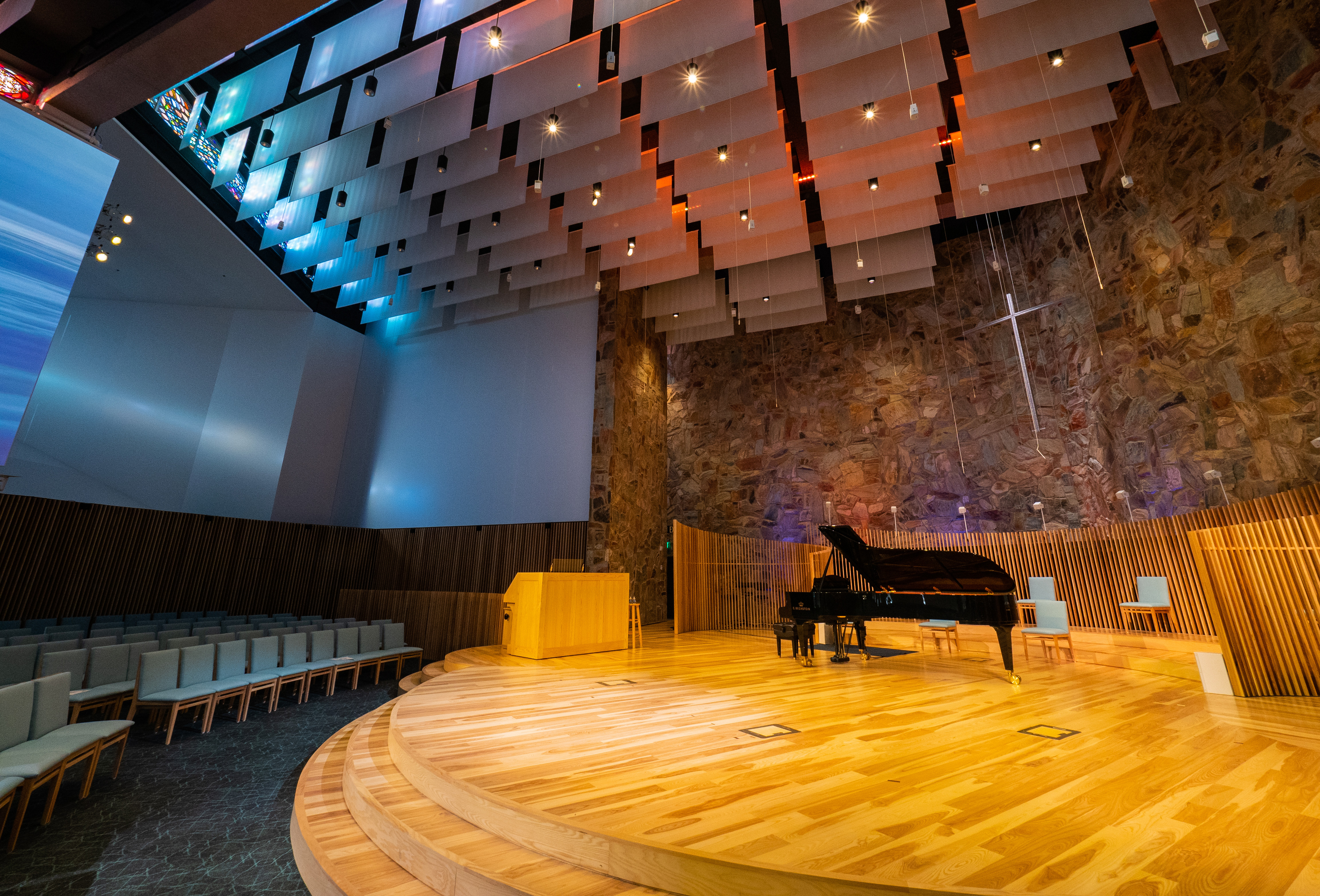When Valley Presbyterian Church in Paradise Valley, AZ decided to renovate its 50-year-old sanctuary, a principal goal was to hold both traditional and contemporary worship services in this one space—but without compromising the music program for either. At the same time, the church wanted to enhance the acoustical flexibility of the 600-seat sanctuary in order to host a range of special concerts and even classical music recording sessions.
“We have a very spacious campus, with our sanctuary for traditional worship at one end and a multi-purpose space where we held contemporary services at the other end,” explained Russ Henzel, who served for 15 years as the church’s volunteer AV technician. “Because of the distance between, we had a split congregation with little interaction between the two groups during social hour. Our goal was to bring the contemporary service into the sanctuary, with socializing in a common space, but we knew its reverberant acoustics would be a major problem.”
[The Integration Guide to Houses of Worship]
This goal was in the brief handed to Jones Studio in Tempe, the project architects, and they enlisted the services of acoustical and media systems consulting firm McKay Conant Hoover (MCH). The MCH team comprised principal in charge David Conant, who oversaw the project, with Taylor Blaine as project manager for acoustics. Randy Willis and the late Kyle Ridenour shared responsibilities for the media systems.
Realizing the desire to significantly alter the acoustical characteristics for both amplified and unamplified music enhancement, as well as the need to instantly switch to a relatively dry acoustic for improved speech intelligibility, the solution recommended by MCH was electroacoustic enhancement.
“The church leaders liked the idea in principle, but like many who are unfamiliar with the technology, some were skeptical,” admitted Conant. “We recommended that they get in touch with Meyer Sound and visit one of the existing Constellation church systems. A delegation led by their minister of music, Jennifer Hamm, listened to Constellation at Laguna Presbyterian in Southern California, and I’m told Ms. Hamm was absolutely delighted with what she heard.”
Aware of the church’s high standards, Conant recommended Constellation as the preferred solution. “Constellation is our go-to system,” he said. “We have a very high comfort level with the technical performance of the system as well as admiration and respect for everybody on the Meyer Sound team. We had listened to other systems and I can say we were underwhelmed by them.”
To prepare for Constellation, MCH specified acoustical treatments that reduced the baseline mid-band RT60 from 1.75 seconds to less than 0.7 seconds and dropped the background noise level from NC 43 to NC 17, resulting in significantly improved speech intelligibility.
To create the desired reverberation characteristics, the Constellation system utilizes 97 MM-4XP miniature surface mount loudspeakers and 11 Ashby-5C flush mount loudspeakers suspended overhead and affixed on the side walls, as well as around the choir area. Low frequency extension of the reverberation envelope—critical for the church’s renovated pipe organ—is furnished by 16 MM-10XP miniature subwoofers. All loudspeakers are self-powered.
Ambient room sound is captured by 28 miniature cardioid microphones, and the eight-module D-Mitri Digital Audio Platform includes two D-VRAS processors for hosting the patented VRAS reverberation algorithm. The Constellation system was installed to Meyer Sound’s exacting specification by Clearwing Systems Integration of Phoenix.
Meyer Sound’s Pierre Germain came in for the tuning, with the results of his work praised as “pretty much spectacular” by the church’s technical staff. Constellation allows for a variety of acoustical environments, from a minimally transparent setting for a rock band or for when the pastor is speaking, with longer settings enabled for sonic immersion by adding natural sustain and decay to the music. Although a full choir is not yet permitted because of the pandemic, Constellation has enhanced vocal and instrumental soloists performing in classical styles as well as the church’s distanced contemporary band.
In addition to music enhancement, Constellation in conjunction with acoustical treatments has improved speech intelligibility. With Constellation off or on a very short setting, the congregation hears only direct sound without destructive reflections.
Constellation can be easily operated by volunteers by selecting fixed presets from a touchscreen, yet the system architecture also allow custom tweaking of parameters. This capability was put to good use when the renowned early music vocal ensemble Helios came to the church to record a concert in cooperation with Central Sound at Arizona PBS. Two special presets were programmed for the occasion, with the ensemble auditioning both prior to recording.
According to Helios tenor Kenny Miller, who is also the group’s executive director, results exceeded expectations. “We were incredibly impressed with the acoustics and the aural flexibility in what is normally a space not suitable for early music,” said Miller. “We have performed in another space in the valley using this type of system from another maker, and it is not even a close comparison.”
